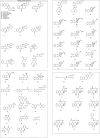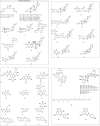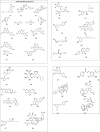Incredible use of plant-derived bioactives as anticancer agents
- PMID: 39835210
- PMCID: PMC11744461
- DOI: 10.1039/d4ra05089d
Incredible use of plant-derived bioactives as anticancer agents
Abstract
Cancer is a major global concern. Despite considerable advancements in cancer therapy and control, there are still large gaps and requirements for development. In recent years, various naturally occurring anticancer drugs have been derived from natural resources, such as alkaloids, glycosides, terpenes, terpenoids, flavones, and polyphenols. Plant-derived substances exhibit their anticancer potential through antiproliferative activity, cytotoxicity, apoptosis, angiogenesis and cell cycle arrest. Natural compounds can affect the molecular activity of cells through various signaling pathways, like the cell cycle pathway, STAT-3 pathway, PI3K/Akt, and Ras/MAP-kinase pathways. Capsaicin, ouabain, and lycopene show their anticancer potential through the STAT-3 pathway in breast, colorectal, pancreatic, lung, cervical, ovarian and colon cancers. Epigallocatechin gallate and emodin target the JNK protein in skin, breast, and lung cancers, while berberine, evodiamine, lycorine, and astragalin exhibit anticancer activity against breast, liver, prostate, pancreatic and skin cancers and leukemia through the PI3K/Akt and Ras/MAP-kinase pathways. In vitro/in vivo investigations revealed that secondary metabolites suppress cancer cells by causing DNA damage and activating apoptosis-inducing enzymes. After a meticulous literature review, the anti-cancer potential, mode of action, and clinical trials of 144 bioactive compounds and their synthetic analogues are included in the present work, which could pave the way for using plant-derived bioactives as anticancer agents.
This journal is © The Royal Society of Chemistry.
Conflict of interest statement
All the authors declared no conflict for the submitted manuscript.
Figures








Similar articles
-
Molecular Targets of Plant-based Alkaloids and Polyphenolics in Liver and Breast Cancer- An Insight into Anticancer Drug Development.Anticancer Agents Med Chem. 2025;25(5):295-312. doi: 10.2174/0118715206302216240628072554. Anticancer Agents Med Chem. 2025. PMID: 38963106 Review.
-
Targeting signaling pathways with andrographolide in cancer therapy (Review).Mol Clin Oncol. 2024 Sep 5;21(5):81. doi: 10.3892/mco.2024.2779. eCollection 2024 Nov. Mol Clin Oncol. 2024. PMID: 39301125 Free PMC article. Review.
-
Anticancer Potential of Quercetin, Epigallocatechin Gallate, Kaempferol, Apigenin, and Curcumin against Several Human Carcinomas.Endocr Metab Immune Disord Drug Targets. 2024 Sep 23. doi: 10.2174/0118715303320523240910072723. Online ahead of print. Endocr Metab Immune Disord Drug Targets. 2024. PMID: 39318018
-
The pivotal role of JAK/STAT and IRS/PI3K signaling pathways in neurodegenerative diseases: Mechanistic approaches to polyphenols and alkaloids.Phytomedicine. 2023 Apr;112:154686. doi: 10.1016/j.phymed.2023.154686. Epub 2023 Jan 31. Phytomedicine. 2023. PMID: 36804755 Review.
-
Anticancer potential of active alkaloids and synthetic analogs derived from marine invertebrates.Eur J Med Chem. 2024 Dec 5;279:116850. doi: 10.1016/j.ejmech.2024.116850. Epub 2024 Sep 6. Eur J Med Chem. 2024. PMID: 39270448 Review.
Cited by
-
Importance of Advanced Detection Methodologies from Plant Cells to Human Microsystems Targeting Anticancer Applications.Int J Mol Sci. 2025 May 14;26(10):4691. doi: 10.3390/ijms26104691. Int J Mol Sci. 2025. PMID: 40429833 Free PMC article. Review.
References
-
- Siegel R. L. Giaquinto A. N. Jemal A. Cancer statistics. Ca-Cancer J. Clin. 2024;74:12–49. - PubMed
-
- Artosi F. Costanza G. Di Prete M. Garofalo V. Lozzi F. Dika E. Cosio T. Diluvio L. Shumak R. G. Lambiase S. Di Raimondo C. Campa S. Piscitelli P. Miani A. Bianchi L. Campione E. Epidemiological and clinical analysis of exposure-related factors in non-melanoma skin cancer: a retrospective cohort study. Environ. Res. 2024;247:118117. - PubMed
-
- Sung H. Ferlay J. Siegel R. L. Laversanne M. Soerjomataram I. Jemal A. Bray F. Global Cancer Statistics 2020: GLOBOCAN Estimates of Incidence and Mortality Worldwide for 36 Cancers in 185 Countries. Ca-Cancer J. Clin. 2021;71:209–249. - PubMed
Publication types
LinkOut - more resources
Full Text Sources
Research Materials
Miscellaneous

